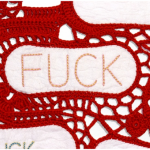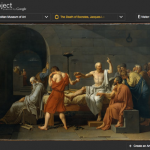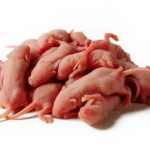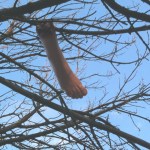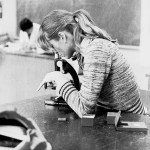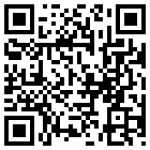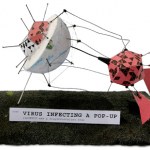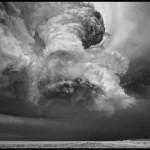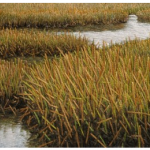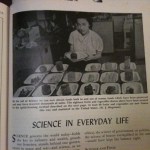
PMS Quilt, 2008
hand embroidered and crocheted pantyliners
Laurel Roth
Yes, that is just what it says it is: a collection of pantyliners embroidered with profanity.
One thing is clear about artist Laurel Roth: she is not afraid to make viewers uncomfortable. Her series "Hope Chest" is constructed of hygenic accessories embroidered with "off-kilter reflections on biology, fertility, and the ever-changing roles of women" - like the f-word. Embellished with beads, rose thorns, and crochet, the embroideries are twee, kitschy decor - or they would be, if not for their bluntly worded messages.…
Experiencing late-afternoon unproductivity? Go play with Google Art Project and virtually tour the world's museums.
Update: NYT review.
Pinkies
from Food Chain: Encounters Between Mates, Predators and Prey by Catherine Chalmers
Photographer Catherine Chalmers (who may be best known in biology circles for her portraits of genetically modified mice) goes beyond brutal accuracy in her animal photography. Food Chain: Encounters Between Mates, Predators and Prey is a book of photos depicting predatory insects, frogs, and snakes devouring their living meals - including naked, squirming baby mice (above). It's no more than honest about what animals do and eat (yes, "cute" frogs will eat baby mice). But Chalmers' ordering and staging…
Gratifyingly, my post on Nabokov and Gould has generated interesting feedback, including this post by Jonah Lehrer, who expands on Nabokov's own opinion of how his science informed his art. (Let's just say he and Gould didn't see eye-to-eye.) The post includes some wonderful Nabokov quotes about science, art, and butterflies, and Lehrer's writing is, as always, lovely:
For Nabokov, the entire universe was just an elaborate puzzle waiting to be figured out. It didn't matter if one was talking about a novel or the evolution of an insect or a chess problem: Nabokov knew that the way to solve the…
Is it advanced physics? biotech? fashion? Heck if I know.
"The Theory of Everything Disguised as a Handbag," from RandomIntent's etsy shop.
Dark pictures, thrones, the stones that pilgrims kiss,
poems that take a thousand years to die
but ape the immortality of this
red label on a little butterfly.
- excerpt from Vladimir Nabokov's "On Discovering a Butterfly"
It's not very well known that novelist Vladimir Nabokov, author of Lolita, was also a lepidopterist; for six years, he was a Research Fellow at the Harvard Museum of Comparative Zoology (now part of the HMNH). Carl Zimmer recounts in the NYT how Harvard professor Naomi Pierce recently set out to test Nabokov's hypotheses about blue butterfly speciation, and discovered…
I have no idea why there is a disembodied mannequin foot in a tree in Cambridge, MA, but so there is. Sort of gruesome, eh? Maybe io9 should do another post on severed limbs.
Update: my friend John O reminds me that he did a post on severed hands two years ago. He beat us all to the punch! (ha ha).
An invitation from scienceforcitizens.net:
As record levels of snow blanket much of the United States this year, Science For Citizens is collaborating with an important climate research project at the University of Waterloo called Snow Tweets. We're pleased that this is the first of many scientific projects that you'll be able to do on Science for Citizens.
To help researchers track climate change, we're requesting that you find a ruler, put on a warm coat, go outside, and measure the depth of snow wherever you happen to be. And then report the depth to us right here. That's all there is to…
I'm honored to get a brief shout-out today from the awesome Ed Yong in his post on female bloggers. I mention this not to toot my own horn, but to call attention to the amazing number of women blogging about scientific research - something I rarely do anymore at BioE, but which is very important to public science literacy, science policy, and inspiring young women to choose careers in science.
Many of the women Ed mentions are already on my blogroll (Sheril Kirshenbaum, Jennifer Ouellette, Scicurious, Janet Stemwedel, to name a few), but I clearly have to add more - including my friend…
I think DNA is amazing. I think biotech inspires great design. And if you've read this blog at all, you know I love sciart. But I just cannot understand the new infogenetics product from DNA 11 - the company behind that trendy gel electrophoresis wall art. While I'd normally just say "I don't get it" and move on, DNA 11 claims that their "augmented art" is "the ultimate intersection of biology, art and technology." I don't know how that could get more squarely in the BioE wheelhouse. So let's take a closer look at how, exactly, biology and art intersect in the "Ancestry Portrait" (pictured…
From NextNature, an intriguing post about the Institute for Digital Biology:
During the exhibition, visitors were able to feed a colony of microscopical pop-up creatures, save Chinese websites from a pageview-shortage, preserve an Amazone tribe from extinction by subscribing to its homepage and view a short documentary on how the living internet established itself.
Artist Walewijn den Boer also created a peculiar, twelve-minute faux-documentary, which uses animation to bring his digital biology concepts into meatspace (check it out below the fold).
Update 1:
I think the clunkiness of the…
How often people speak of art and science as though they were two entirely different things, with no interconnection. An artist is emotional, they think, and uses only his intuition; he sees all at once and has no need of reason. A scientist is cold, they think, and uses only his reason; he argues carefully step by step, and needs no imagination. That is all wrong. The true artist is quite rational as well as imaginative and knows what he is doing; if he does not, his art suffers. The true scientist is quite imaginative as well as rational, and sometimes leaps to solutions where reason can…
Joe DePasquale was a winner of the European Southern Observatory's hidden treasures 2010 competition with this lovely photo. From ESO:
"The pictures of the Universe that can be seen in ESO's releases are impressive. However, many hours of skilful work are required to assemble the raw greyscale data captured by the telescopes into these colourful images, correcting them for distortions and unwanted signatures of the instrument, and enhancing them so as to bring out the details contained in the astronomical data. ESO has a team of professional image processors, but for the ESO's Hidden…
It might look something like this:
Arm of God
Galacia, Kansas 2009Mitch Dobrowner
Those of you who enjoyed Sean Heavey's photos of storms in the American West may appreciate this epic, crisp black-and-white storm photography by Mitch Dobrowner.
Vapor Cloud
Near Clayton, New Mexico 2009
Mitch Dobrowner
In addition to his website, you can find Dobrowner's work at Ordover Gallery and John Cleary Gallery, among others. He will be exhibiting in April 2011 at Portland, Oregon's Blue Sky Gallery.
Via NOTCOT.
I got a very nice email today from Sam Gaty, one of the filmmakers behind the Synthetic Biology Documentary I blogged about earlier. He acknowledged the "mad scientist" type concerns, but emphasized that's not what they're going for in the final documentary, and suggested I share another short clip. This one is far more, I don't know how to describe it, techno-chic?
I can definitely see that sort of presentation getting kids interested in biology. It spins bench science as something intriguing, cutting edge, maybe a little hipster. Framing really is all in the aesthetics, isn't it?
Check…
An impressive short film, "Core," by animation group selfburning, via Fubiz. The music is lovely.
So I'm all in favor of promoting struggling artists, and that includes documentary filmmakers. But I have to say I'm a little taken aback by the aesthetic of the "Synthetic Bio" documentary project by Field Test Films (and endorsed by Carl Zimmer). They've posted a short over at Kickstarter, where they're trying to raise $30K to finish the film in time for Sundance. But as one of my biologist friends pointed out, the soundtrack they use for the sample short (on producing spider silk in goat's milk) is eerie, mad-scientist stuff, complete with a Exorcist-like choir at the end.
I'm posting the…
Autumn Salt Marsh 2
Linda Behar
I defy you to look at Linda Behar's embroidered marshlands and not be fooled into thinking they're photographs. To achieve this unusual level of textile realism, she prints photos taken on-site onto cloth, then improvises over them with embroidery. See more of her work on flickr.
Via Daily Art Muse.
Psychologist Robert Kurzban's new book promises to explain Why Everyone (Else) Is a Hypocrite. It's a bold promise, and I was skeptical when first invited to review it. But Kurzban delivered - hilariously, entertainingly so. Although since I agree with almost everything he writes, I may not be the most objective of critics. (FYI: this is a long review, so if you're short on time, you can skip to the end of the post, and watch the author's short video trailer about the book. Cheers.)
For starters, Kurzban has convinced me to be more careful when I talk and write about my brain (and yours).…
I found this children's encyclopedia in a pile of books on the curb a few weeks ago. Some of its depictions of science are charming; some are odd, and all are really, really dated. More snapshots below the fold. . .
